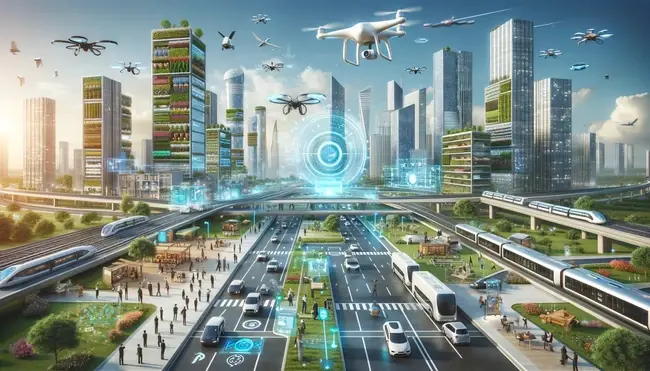
There are a number of threads we could pull in emerging technologies, so boiling the list down to five is difficult. Of course this is my own limit, so I suppose there’s some argument to expand the list. I’ll resist that though, and try to focus these few trends on the most consequential in the areas in which I am currently focused; customer experience and CRM, artificial intelligence (AI) and adopting a digital first business strategy. Even with that focus I struggled to keep the list to five, but here’s where I landed:
AI Application Stores
Generative AI as the new platform
Quantum Computing + AI
Synthetic Customers
Large Vision Models (LVMs)
AI Application Stores
AI application stores, as they emerge in 2024, represent a shift in how businesses and consumers access and utilize generative AI and other AI tools. The model is of course, very familiar to most of us with the widespread use of mobile phone app stores and enterprise solution provider app stores; and are essentially digital marketplaces where various AI applications, models, and tools are made available, often tailored to specific industries or functions. OpenAI announced their version at their recent DevDay, now launching early 2024. Here's how they will change the AI landscape:
Benefits of AI Application Stores
Accessibility and Customization: Businesses and consumers can access a wide range of AI tools that are tailored to their specific needs. This level of customization enhances efficiency and effectiveness in various applications.
Cost-Effectiveness: These stores allow for a more economical approach to AI adoption. Smaller businesses can access advanced AI technologies without the need for significant investment in R&D.
Rapid Integration and Deployment: AI application stores streamline the process of integrating AI into existing systems. This accelerates the adoption curve and enables faster deployment.
Quality and Reliability: AI tools available in these stores often undergo rigorous vetting and quality checks, ensuring reliability and performance.
Continuous Updates and Support: Continuous updates ensure that the AI applications remain cutting-edge, and support services help businesses to effectively utilize these tools.
Challenges and Potential Risks
Security Concerns: With the widespread distribution of AI tools, there is a heightened risk of security breaches and misuse of AI technologies.
Quality Control: While there are standards for vetting, the sheer volume of applications could lead to inconsistencies in quality and performance.
Privacy Issues: The use of AI applications raises concerns about data privacy, especially in applications that handle sensitive information.
Market Monopolization: The risk of market monopolization by a few dominant AI application providers could stifle innovation and lead to higher prices.
Ethical and Societal Impacts: The widespread use of AI could have unforeseen ethical and societal implications, such as job displacement and ethical dilemmas in decision-making.
AI application stores in 2024 are poised to significantly change how businesses and consumers implement and use AI tools. They offer big benefits to both consumers and businesses in terms of accessibility, cost, and efficiency. However, these advantages come with their own set of challenges and risks, particularly in terms of security, privacy, and ethical considerations. It is imperative for businesses and consumers to approach these new opportunities with a balanced perspective, weighing the benefits against the potential pitfalls. Responsible use and regulation will be key in ensuring these AI marketplaces contribute positively to technological advancement and societal welfare.
Generative AI as the New Platform
The concept of generative AI as the new technology platform can be understood by examining its impact on both consumers and businesses, and how it represents a fundamental shift in the way technology is integrated into our daily lives.
For Consumers: Transition to a Personalized Internet with Conversational UI
Generative AI as a Platform: At its core, generative AI is not just a tool but a platform, meaning it provides a foundational layer upon which various applications and services are built. This is akin to how the internet served as a platform for web services and social media.
From Transactional to Personalized Internet: Traditional internet experiences have been largely transactional, based on user inputs leading to specific outputs. Generative AI transforms this dynamic into a more personalized experience. It understands and anticipates user needs, offering customized content, suggestions, and interactions.
Conversational User Interface (UI): One of the most significant consumer-facing aspects of generative AI is the conversational UI. This allows for more natural, intuitive interactions with technology, moving beyond the click-based interfaces to ones that understand and respond to natural language, making technology more accessible and user-friendly.
For Businesses: Enhancing Productivity and Systematic Integration
New Ways of Work: Generative AI introduces new paradigms in how work is done. It automates routine tasks, generates creative solutions, and assists in complex decision-making processes, fundamentally changing job roles and workflows.
Increasing Productivity: By taking over repetitive and time-consuming tasks, generative AI frees up human employees to focus on more strategic, creative, or complex problems, thereby increasing overall productivity.
Systematic Approach with Enterprise Integration: Unlike standalone tools, generative AI can be systematically embedded into enterprise applications. This means it can be integrated across various business functions - from customer service to data analysis, marketing, and beyond - creating a more cohesive and efficient operational framework.
New Platform Benefits
Scalability and Flexibility: As a platform, generative AI can scale across different sectors and industries, adapting to specific needs and challenges. It’s not limited to one application, making it a versatile foundation for future technological developments.
Data Utilization and Learning: Generative AI platforms learn from data, continuously improving and providing more accurate, personalized outputs. This learning aspect makes it increasingly valuable over time.
Accessibility and Democratization of Technology: With its user-friendly interfaces and ability to tailor experiences, generative AI makes technology more accessible to a broader range of users, democratizing access to advanced digital tools.
Economic Impact: For businesses, the productivity gains and efficiencies offered by generative AI can lead to significant economic benefits. It also opens up new business models and revenue streams, particularly in sectors where AI can provide unique insights or services.
Generative AI as a new tech platform is transformative for both consumers and businesses. For consumers, it represents a shift towards a more personalized, conversational internet experience. For businesses, it offers new ways of working, increased productivity, and a systematic approach to embedding technology across various functions. This platform is not just about individual technologies or applications, but about a new way of interacting with and leveraging technology in our daily lives and work.
Quantum Computing + AI
The impact of quantum computing on AI and generative AI, particularly as they evolve in the coming year, is a subject of much interest and speculation. Whether it will have significant impact in the short term is questionable, but bears exploring. As with most technological innovations, we often underestimate the pace of change that it can achieve. Here are some key points to consider:
Enhanced Computational Power: Quantum computers operate on quantum bits (qubits), which can represent multiple states simultaneously, unlike classical bits that are either 0 or 1. This allows quantum computers to perform complex calculations at speeds unattainable by traditional computers. For AI, this means potentially faster processing of large datasets and more efficient training of models.
Improved Machine Learning Algorithms: Quantum computing could enable the development of new, more efficient machine learning algorithms. Quantum algorithms, for instance, could enhance the speed and efficiency of optimization and sampling tasks, which are fundamental to many AI processes, including generative AI.
Solving Complex Problems: Some problems in AI, particularly those involving combinatorial optimization or exploring vast solution spaces, are currently intractable for classical computers due to their computational complexity. Quantum computing could make these problems more manageable, leading to breakthroughs in AI capabilities.
Impact on Generative AI: Generative AI, which includes technologies like GPT (Generative Pre-trained Transformer) and DALL-E, could see significant advancements with quantum computing. Faster computation and advanced algorithms could lead to more sophisticated and nuanced AI-generated content, whether it's text, images, or even code.
Data Privacy and Security: Quantum computing poses new challenges and opportunities for data security. While it could potentially break many of the current encryption methods, leading to data privacy concerns, it also offers the prospect of quantum encryption methods, which could be far more secure.
Resource Intensity and Accessibility: Currently, quantum computing is resource-intensive and not widely accessible. Its integration with AI would require significant infrastructure and expertise, which might initially limit its use to well-funded organizations or specific sectors.
Ethical and Societal Implications: With advanced AI capabilities powered by quantum computing, there would be significant ethical and societal implications, including concerns about job displacement, privacy, and the control of powerful AI systems.
While quantum computing offers exciting possibilities for AI and generative AI, its practical impact in the next year will depend on technological advancements, infrastructural development, and addressing various ethical, security, and societal challenges. It's an area of rapid development, but full-scale integration of quantum computing with AI is likely a mid to longer-term prospect.
Synthetic Customers
Synthetic customers, also known as virtual or digital customers, are AI-generated personas that simulate real customer behaviors, preferences, and interactions. They are used in various industries, particularly in marketing, retail, and customer service, to improve customer experience, product development, and business strategies. One unique use case though, is in drug trials, where synthetic patients could accelerate the drug trials process significantly while increasing drug trial safety and reducing risks. Here's an overview of the technology used to create them:
Artificial Intelligence (AI) and Machine Learning (ML): At the core of synthetic customers are AI and ML algorithms. These technologies analyze vast amounts of data to understand customer patterns, preferences, and behaviors. By processing this data, AI can create detailed customer profiles that mimic real-world consumers.
Natural Language Processing (NLP): NLP is crucial for enabling synthetic customers to understand and generate human-like text and speech. This allows for realistic interactions with human users or other AI systems, making them useful for tasks like customer service chatbots or interactive marketing campaigns.
Data Analytics: Synthetic customers rely heavily on data analytics to simulate real customer behavior. This involves analyzing historical customer data, market trends, and other relevant information to create accurate and believable customer profiles.
Predictive Modeling: By using predictive modeling, synthetic customers can forecast future customer behaviors and preferences. This helps businesses in decision-making and strategy formulation, as they can anticipate market trends and customer needs more effectively.
Computer Vision: In some cases, synthetic customers may utilize computer vision technologies, especially in scenarios where visual interaction or product visualization is important.
Voice Recognition and Synthesis: For applications involving voice interactions, technologies like voice recognition and synthesis are used. This enables synthetic customers to engage in realistic spoken conversations, enhancing their usability in voice-based systems.
Simulation and Modeling Software: These tools are used to create complex models of customer behavior and market dynamics. They can simulate various scenarios, helping businesses understand how synthetic customers might react under different conditions.
IoT and Sensor Data: For more immersive experiences, synthetic customers might also integrate data from IoT devices and sensors, providing a more holistic view of customer behaviors and preferences in real-time environments.
By using these technologies, synthetic customers can offer valuable insights and contribute to enhanced customer experiences, more efficient service delivery, and better-informed business strategies.
Large Vision Models
Large Vision Models (LVMs) are advanced AI systems that have significantly impacted various sectors, including business and consumer domains.
Definition: LVMs are AI models that process and interpret visual data. They are "large" in the sense that they are trained on vast datasets and have a high number of parameters, enabling them to recognize, categorize, and interact with a wide array of visual inputs.
Capabilities: These models can perform tasks like image recognition, object detection, scene reconstruction, and even generating visual content. They leverage deep learning, particularly convolutional neural networks (CNNs) and sometimes transformer models, to understand and analyze visual data.
Impact on Businesses
Enhanced Automation: LVMs facilitate automation in industries like manufacturing, where they can identify defects in products, or in retail, for inventory management through visual stock tracking.
Improved Customer Experience: In the consumer sector, they enhance user experience through personalized content recommendations in apps and websites, and in virtual try-on features in fashion and retail.
Marketing and Advertising: LVMs enable sophisticated targeted advertising by analyzing consumer preferences through visual cues, improving engagement and conversion rates.
Data Analytics: Businesses use LVMs for advanced data analytics, such as analyzing consumer behavior through CCTV footage in physical stores.
Impact on Consumers
Personalization: Consumers enjoy more personalized experiences in services and product offerings, as LVMs enable businesses to understand and predict consumer preferences better.
Accessibility: They enhance accessibility features, like aiding visually impaired individuals in navigating environments or understanding visual content.
Enhanced Interactions: Integration in devices and applications offers more intuitive and engaging user interfaces, like augmented reality (AR) features in apps.
Benefits
Efficiency and Accuracy: LVMs can process and analyze visual data more quickly and accurately than humans, leading to efficiency gains.
Scalability: They can be scaled to handle large volumes of data, making them suitable for big data applications.
Innovation: LVMs drive innovation, leading to new products and services that were not possible before.
Challenges and Risks
Data Privacy: The use of LVMs raises significant data privacy concerns, especially when processing personal or sensitive visual data.
Bias and Fairness: If trained on biased datasets, LVMs can perpetuate or amplify these biases, leading to unfair outcomes.
Regulatory Compliance: Ensuring that LVMs comply with evolving legal frameworks around AI and data use is a challenge.
Computational and Environmental Cost: The training and operation of LVMs require significant computational resources, leading to high energy consumption and environmental impact.
Security: LVMs pose new security risks, including vulnerability to adversarial attacks that can manipulate their outputs.
Large Vision Models represent a significant advancement in AI technology, offering substantial benefits to businesses and consumers. However, their deployment must be managed carefully to address the challenges and risks associated with privacy, bias, security, and regulatory compliance. As these models continue to evolve, so too will the strategies to mitigate these risks while maximizing their potential benefits.
So that’s my top five for 2024. I could have added many more, but from a focus perspective these are currently top of my list. With the pace of change in AI technologies and technology in general, there could be a whole new set of trends in a short period of time. Reach out if you’d like to explore these and other trends of interest in more detail.












